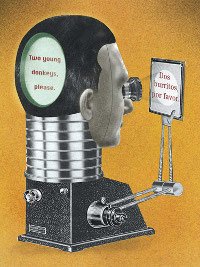| Pages in topic: [1 2] > | Why translate DOCX in a dedicated CAT tool? Thread poster: 2nl (X)
|
|---|
2nl (X) 
Netherlands
Local time: 03:22
For a presentation I'm looking for arguments for translating Microsoft Word documents in a dedicated CAT tool rather than in Microsoft Word with a CAT plug-in. Please note that I am not questioning the advantages of using Microsoft Word together with a CAT plug-in...
Filtering
One of the mayor advantages of dedicated CAT tools is their ability to filter segments. Some examples:
* Filter on SL segments that contain 'grau'.
* Filter on TL segment... See more For a presentation I'm looking for arguments for translating Microsoft Word documents in a dedicated CAT tool rather than in Microsoft Word with a CAT plug-in. Please note that I am not questioning the advantages of using Microsoft Word together with a CAT plug-in...
Filtering
One of the mayor advantages of dedicated CAT tools is their ability to filter segments. Some examples:
* Filter on SL segments that contain 'grau'.
* Filter on TL segments that contain 'grey'.
* Filter on SL segments that contain 'grau' where the corresponding TL segment contains 'gray'.
* Filter on SL segments that contain 'grau' where the corresponding TL segment contains 'gray' but the SL segment doesn't end with a semicolon.
Finding and Replacing
Related to this are the many Find and Replace actions that can be handled with filtering. Again some examples:
* Only in those segment pairs where the SL contains 'grau', replace 'gray' with 'grey' in the TL.
* Replace 'gray' with 'grey' in the TL of the current translation project, in all connected translation memories and termbases simultaneously.
Display
Another advantage of dedicated CAT tools is a WYSIWYG representation of files that cannot be handled in Word directly.
Tags
(Addition: This doesn't apply to DOCX files.)
I am not sure whether the combination of Word + plug-in can protect and/or collapse tags in files that cannot be handled in Word directly. (Addition: This is only valid for certain file formats.)
Other tasks?
What other translation tasks do you perform in your dedicated CAT tool, that cannot be done in Word + plug-in?
[Edited at 2014-12-13 10:05 GMT] ▲ Collapse
| | | | | Contradiction | Dec 13, 2014 |
2nl wrote:
I'm looking for arguments for translating Microsoft Word documents in a dedicated CAT tool rather than in Microsoft Word with a CAT plug-in.
Another advantage of dedicated CAT tools is a WYSIWYG representation of files that cannot be handled in Word directly.
You start with the assumption one is going to translate Word documents. Then you go on and praise dedicated CAT tools for being able to display non-Word documents. Your logic is flawed.
Besides, what is the "WYSIWYG representation" of an IDML file in a dedicated CAT tool?! Except perhaps in memoQ + Language Terminal.
| | | | 2nl (X) 
Netherlands
Local time: 03:22
TOPIC STARTER | Glueing files | Dec 13, 2014 |
Yes, you were right. I edited my original posting to make the change of topic more clear. Thank you!
I just realised that with my pre morning coffee head I just forgot one very important feature of dedicated CAT tools:
Glueing individual files
With a dedicated CAT tool you can easily virtually glue individual files in a translation project together. After that, you can load and even remove them individually. The order and names of the individual file... See more Yes, you were right. I edited my original posting to make the change of topic more clear. Thank you!
I just realised that with my pre morning coffee head I just forgot one very important feature of dedicated CAT tools:
Glueing individual files
With a dedicated CAT tool you can easily virtually glue individual files in a translation project together. After that, you can load and even remove them individually. The order and names of the individual files can be modified to your preferences. ▲ Collapse
| | | | Emma Goldsmith 
Spain
Local time: 03:22
Member (2004)
Spanish to English
A dedicated CAT tool offers lots of QA checks:
- flag untranslated segments (these can be skipped by accident if you work directly in Word)
- source and target match each other in terms of figures, punctuation endings, capitalisation, etc.
- terminology is consistent with glossaries
- check for extra spaces, dots, etc.
| | |
|
|
|
MikeTrans
Germany
Local time: 03:22
Italian to German
+ ...
| Server-based work, live file versioning, and... optimized engines | Dec 13, 2014 |
Hi,
I don't do this, but if you work within a web group, then you must know at any moment what the current version of your translated files is. Other than filtering, it's important that your CAT can display in a meaningful way all tracked changes from a specific translator or reviewer, the ability to quickly and efficiently access to notes and comments, features that MS-Word could do, but not 'live' and not in such a specialized way translators require.
Then, there is t... See more Hi,
I don't do this, but if you work within a web group, then you must know at any moment what the current version of your translated files is. Other than filtering, it's important that your CAT can display in a meaningful way all tracked changes from a specific translator or reviewer, the ability to quickly and efficiently access to notes and comments, features that MS-Word could do, but not 'live' and not in such a specialized way translators require.
Then, there is the question of database management, organizing a translation memory or terminology contents. All this could probably be done with MS-Word (Wordfast Classic is a good example), but specialized CATs are more versatile with more features and export/import options.
[ADD]
A crucial point is File Portability. Most specialized software that handle documentations use the XML format to exchange information and documents. MS-Word is a very bad XML editor, or I've missed some feature over the last 20 years...
At last, there is a main technical reason for having a dedicated environement:
A good CAT tool needs a good engine capable of handling large databases able to access entries fast, unaware of top-nodge computer systems. MS-Office will not meet this requirement, as well as the Windows Notepad is not able to load and handle reasonably a 2 GB text file, nor is MS-Excel which has a limit of entries that a specific sheet can have as well as the lenght of the entry itself.
Mike
[Edited at 2014-12-13 13:35 GMT] ▲ Collapse
| | | | nrichy (X)
France
Local time: 03:22
French to Dutch
+ ...
| On the contrary | Dec 13, 2014 |
2nl wrote:
What other translation tasks do you perform in your dedicated CAT tool, that cannot be done in Word + plug-in?
Well, I have both. And I do things in my Word +plugin (in this case, Wordfast Classic) I cannot do in the dedicated tool:
- VERY quick translation turnover because of shortened workflow (choose the file to translate + choose the TM + choose the glossary, if any => translate => clean up => deliver).
This outweighs all other arguments.
And also because of automatic propagation of glossaries, and some other features which are very simple to use.
I use the standalone solution (Studio) when I have other file formats to translate, or if I want to use several TMs at the same time, but tweaking takes always a lot of time.
I hop between both and do limited TM management, but am a translator, not a creator of supplementary problems.
And sometimes no CAT at all, specially for marketing texts (vocabulary is in my head).
| | | | neilmac
Spain
Local time: 03:22
Spanish to English
+ ...
I'm afraid I don't really understand the distinction posed in the question (or some of the parameters mentioned).*
All I can say is that I've been using Wordfast Classic to translate Microsoft Office Word, Excel and PowerPoint files for a few years now. I'd always thought it was a CAT tool but now I find that apparently it's just a humble plug-in. I researched Trados before deciding that it wasn't for me, and apart from that I only have experience with Deja Vu, which I didn't really like ... See more I'm afraid I don't really understand the distinction posed in the question (or some of the parameters mentioned).*
All I can say is that I've been using Wordfast Classic to translate Microsoft Office Word, Excel and PowerPoint files for a few years now. I'd always thought it was a CAT tool but now I find that apparently it's just a humble plug-in. I researched Trados before deciding that it wasn't for me, and apart from that I only have experience with Deja Vu, which I didn't really like either.
Perhaps in my case ignorance is bliss...
* For example, that whole section about filters is Greek to me.
[Edited at 2014-12-14 14:39 GMT] ▲ Collapse
| | | | Samuel Murray 
Netherlands
Local time: 03:22
Member (2006)
English to Afrikaans
+ ...
2nl wrote:
One of the mayor advantages of dedicated CAT tools is their ability to filter segments.
By "filtering" I assume you mean the ablility to display only segments that confirm to the filter (or to *not* display them). I think that a filtering option would be difficult to create in an MS Word environment, unless you create a separate dialog for it. An alternative method of filtering in e.g. Wordfast may be if there could be a feature that performs a concordance search on an existing concordance search result. That would enable the translator to drill down (filter). To make the feature complete, it should then be possible to make changes to the search result window and then press a button that updates the main translation window with all changes from that search result window. I don't think that that would be too difficult to program. But it would certainly be a slower process visually than the near-instant filtering offered by non-Word programs.
Not all non-Word CAT tools offer filtering, though. Some can only filter by segment status, whereas others can display the filtered segments only in a separate window (while the main window still shows all segments) (e.g. OmegaT). Some tools can only apply one filter at a time (e.g. Trados 2011).
Related to this are the many Find and Replace actions that can be handled with filtering.
* Only in those segment pairs where the SL contains 'grau', replace 'gray' with 'grey' in the TL.
* Replace 'gray' with 'grey' in the TL of the current translation project, in all connected translation memories and termbases simultaneously.
Fairly easy to implement in a Word-based tool, I think. You can "filter" segments using segment highlighting, or by temporarily marking filtered-out segments as hidden text, and then perform the find/replace operation on that which is not highlighted or not hidden.
Another advantage of dedicated CAT tools is a WYSIWYG representation of files that cannot be handled in Word directly.
Nope, it's the other way around. If you translate Word files in Word, then you get the best kind of WYSIWIG possible. If you translate non-Word files in either Word or a non-Word tool, you don't get any kind of WYSIWIG unless the CAT tool has some sort of link to a previewing program.
I am not sure whether the combination of Word + plug-in can protect and/or collapse tags in files that cannot be handled in Word directly. (Addition: This is only valid for certain file formats.)
I think Wordfast Classic does a pretty good job of doing that. Some newer versions of Wordfast can collapse tags and/or protect them from editing, but I have found (as a Wordfast Classic user regularly dealing with tagged text) that the implementation of those features are not ideal and that having to watch out for accidental tag editing is just something you have to deal with. Anyway, the moment you move to the next segment, and there is something not quite right with the tags, Wordfast Classic warns you about it... and it also warns you about it at the end, when you do a document-wide quality check, which includes a tag check.
What other translation tasks do you perform in your dedicated CAT tool, that cannot be done in Word + plug-in?
Simple project management comes to mind. With Word-based tools, the CAT tool is simply a translation environment, and the translator has to ensure that the correct files are in the correct locations and that he's working on copies of files when that is required, etc, whereas with the non-Word tools the project file management is often taken care of (or enforced) by the tool.
| | |
|
|
|
Samuel Murray 
Netherlands
Local time: 03:22
Member (2006)
English to Afrikaans
+ ...
Nicolette Richy wrote:
- VERY quick translation turnover because of shortened workflow (choose the file to translate + choose the TM + choose the glossary, if any => translate => clean up => deliver).
You can make it even shorter, if you create INI files that already specify the correct TM and glossary. Then it's a matter of... open the file, select the appropriate INI, translate the file, clean up, deliver (this short description obviously excludes some steps, e.g. proofreading).
And also because of automatic propagation of glossaries, and some other features which are very simple to use.
Wordfast Classic (WFC) can't auto-propagate glossary terms, in the sense that some other tools do it. WFC can only automatically insert glossary translations into the current segment, but can't touch the content of non-active segments.
If you get a 100% match in WFC and change it, WFC can't update the previous instance of that same segment automatically, unless you count doing pre-translation rounds on the entire file at some points during the translation process.
| | | | 2nl (X) 
Netherlands
Local time: 03:22
TOPIC STARTER | Thank you for all your answers! | Dec 14, 2014 |
Thank you all very much for your answers. I think that I can give some good arguments during my presentation. I'll be promoting the view that dedicated CAT tools are a great help for certain types of texts. Other translators will promote their view that doing everything in Word has great advantages. And we'll both be right  . À chacun son goût. . À chacun son goût.
Thanks again!
Hans
| | | | Samuel Murray 
Netherlands
Local time: 03:22
Member (2006)
English to Afrikaans
+ ...
| Using larger TMs and glossaries, and | Dec 14, 2014 |
MikeTrans wrote:
A good CAT tool needs a good engine capable of handling large databases able to access entries fast...
Well, I think that that is where plug-ins come in, or the ability for a tool to consult third-party resources. Wordfast Classic (WFC) can consult only two TMs at a time, but one can upload many TMs to one's personal space on Wordfast Anywhere (WFA) and then connect to WFA's TMs using WFC.
WFC used to come with a utility called Wordfast Server, which was a small external TM engine that allowed WFC to use very large TMs outside of MS Word's own capabilities. I'm not sure what had happened to it.
A crucial point is File Portability. Most specialized software that handle documentations use the XML format to exchange information and documents.
Are you sure about this? I know many such softwares use XML-type file formats, but I don't think they use it "to exchange information" (at least not to exchange information beyond their designed workflows). Yes, theoretically, having an XML-based file format might make it easier or more likely possible to exchange information, but in practice most tools can't read each other's formats as seamlessly as that.
MS-Word is a very bad XML editor, or I've missed some feature over the last 20 years...
No, it still is pretty bad. I regularly edit XML files in MS Word, using WFC (as "encoded text", not as "xml"), but I only skim the surface of XML because I only edit the translatable text, and only if the translatable text is broadly human-readable. That said, most of my clients whose systems use XML-type files don't send me the XML files... they send me Trados files, or MemoQ files, etc, that were converted from those XML files, and every layer of CAT tool removes more functionality from the original XML file.
I recall a client recently sending me a Trados 2011 project containing about 200 XML files. Fortunately the client also sent the original XML files. So I translated the original XML files using WFC (it was dead simple), and then used the created TM to pre-translate the Trados files (since I was able to mark up the XML files in WFC so that the tags are in the same places as Trados would be expecting them), and that was that. Much faster and less painful as it would have been to translate the Trados files in Trados itself, since I was able to access the hidden *crucially useful* information in the XML files themselves, which would not have been possible from within Trados, and because I was in fuller control over which text should be a temporary tag (i.e. a tag in WFC's editor, but not in the final TM) and which shouldn't.
| | | | Samuel Murray 
Netherlands
Local time: 03:22
Member (2006)
English to Afrikaans
+ ...
2nl wrote:
With a dedicated CAT tool you can easily virtually glue individual files in a translation project together. After that, you can load and even remove them individually. The order and names of the individual files can be modified to your preferences.
That really depends on the CAT tool. Not all non-Word CAT tools can do that. I agree that you would not be able to do that with MS Word if the files were actual Word files, because merging the files would potentially mess up the file templates.
However, nothing prevents you from merging plaintext type formats in an MS Word environment, using file merge macros. I regularly do it when I get jobs that consist of e.g. ten TTX files or ten TXML files -- I merge them into a single plaintext file, and then translate that using WFC as a single MS Word file. Afterwards, I split them again, with a macro.
| | |
|
|
|
Samuel Murray 
Netherlands
Local time: 03:22
Member (2006)
English to Afrikaans
+ ...
Emma Goldsmith wrote:
A dedicated CAT tool offers lots of QA checks:
- flag untranslated segments (these can be skipped by accident if you work directly in Word)
- source and target match each other in terms of figures, punctuation endings, capitalisation, etc.
- terminology is consistent with glossaries
- check for extra spaces, dots, etc.
WFC offers most (or all) of this. I would be surprised if the other Word-based CAT tools (e.g. Metatexis) don't do the same as well.
I concur that WFC's glossary checks are very poor (well, very poor for languages that use compound nouns or that use prefixes more than suffixes), though. The WFC glossary checks are almost useless to me, as they produce 99% false positives, and the QA results are not sortable (the results are in the same order as the segments in the file).
| | | | | Wordfast Server | Dec 14, 2014 |
Samuel Murray wrote:
WFC used to come with a utility called Wordfast Server, which was a small external TM engine that allowed WFC to use very large TMs outside of MS Word's own capabilities. I'm not sure what had happened to it.
WFC never "came with" Wordfast Server, but Wordfast Server is still available, although it is not primarily intended for local use with a single copy of WFC:
http://www.wordfast.com/products_wordfast_server
| | | | Didier Briel 
France
Local time: 03:22
English to French
+ ...
| OmegaT displays filtered results in the main window | Dec 14, 2014 |
Samuel Murray wrote:
Not all non-Word CAT tools offer filtering, though. Some can only filter by segment status, whereas others can display the filtered segments only in a separate window (while the main window still shows all segments) (e.g. OmegaT).
When you apply a filter in OmegaT, the result is displayed in the Editor, which is the main window.
Or did I misunderstand what you wrote?
Didier
| | | | | Pages in topic: [1 2] > | To report site rules violations or get help, contact a site moderator: You can also contact site staff by submitting a support request » Why translate DOCX in a dedicated CAT tool? | Trados Studio 2022 Freelance | The leading translation software used by over 270,000 translators.
Designed with your feedback in mind, Trados Studio 2022 delivers an unrivalled, powerful desktop
and cloud solution, empowering you to work in the most efficient and cost-effective way.
More info » |
| | Wordfast Pro | Translation Memory Software for Any Platform
Exclusive discount for ProZ.com users!
Save over 13% when purchasing Wordfast Pro through ProZ.com. Wordfast is the world's #1 provider of platform-independent Translation Memory software. Consistently ranked the most user-friendly and highest value
Buy now! » |
|
| | | | X Sign in to your ProZ.com account... | | | | | |









